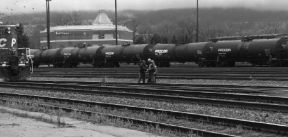
6 January 2006
What's Riding Rails Through Tri-Cities?
| |

What's in the rail cars that travel through the
Tri-Cities? Only CP Rail knows but information is readily available to cities.
|
Trains play a big part of life in the Tri-Cities: They shaped the history of
Maillardville and Coquitlam, in Port Moody they're celebrated annually during Golden Spike Days, and it's hard to miss the sprawling
rail yard in Port Coquitlam.
Most Tri-City drivers frequently encounter trains as they wind their way through town but, apart from some graffiti, the sturdy metal
containers aren't much to look at and give little clue as to what's inside.
About 35 to 40 trains go through the Tri-Cities in an average 24-hour period, with cargoes coming from and going to points throughout
B.C., Canada and abroad. Most of Canadian Pacific Railway's loads - about 95% - consist of grain, coal, forest products, consumer goods,
steel, and automobiles. "Pretty much anything you would use in your home or business," said CPR spokesperson Ed Greenberg.
The remaining 5% are regulated commodities, including oil and gas, diesel, propane, antifreeze, and agricultural products, from
fertilizer to ammonia. "It varies from day to day, what products are being moved," said Greenberg. "It's a heavily
regulated industry and we meet or exceed regulations in Canada and the U.S."
There were 17 incidents involving CPR trains in B.C. last year, 10 of which were minor events, with one or two cars still upright but
off the tracks. The rest were incidents where more than two cars slipped off the tracks, though not all were derailments with cars on
their sides, Greenberg explained.
The Tri-Cities don't have specific plans in case of derailment but tailor their emergency response depending on the circumstances.
Dangers such as fire, leaks, wind direction, and the contents of adjoining cars come into play when responding to a derailment, said
Port Coquitlam's assistant fire chief Terry Hochstetter. Alerting the public, evacuations, and transporting people to hospital are also
part of general response measures.
Heather MacPherson, Port Moody's deputy emergency co-ordinator, said the city's emergency preparedness follows guidelines
from the Provincial Emergency Program. "We're doing a risk analysis of the city and [a derailment response plan] is something
we'll be looking at," she said. "Right now, we have a generic plan for what to do in a major emergency."
Fire and police officials aren't notified beforehand if dangerous goods are being shipped through the Tri-Cities but
Greenberg said cargo details are readily available to them upon request. The company does comprehensive track and train maintenance,
inspections, and monitoring regularly, he added. Hazardous goods are transported in special cars with double reinforced liners and
protective domes, and go through extra inspections before and after loading.
While prevention is key, said Greenberg, CPR has an emergency response contractor network at strategic locations throughout its system
in case of a derailment and spill. Environmental experts are on call to perform first response duties or support CPR's emergency
response staff.
|